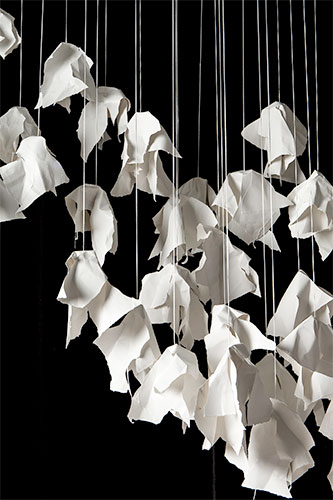 A one-night-only student showcase, “Co-Memory and The Motion of Falling Bodies,” featuring the works of University of Alabama at Birmingham students, is set for 6-8 p.m. Friday, Dec. 4, at Project Space, 900 13th St. South.
A one-night-only student showcase, “Co-Memory and The Motion of Falling Bodies,” featuring the works of University of Alabama at Birmingham students, is set for 6-8 p.m. Friday, Dec. 4, at Project Space, 900 13th St. South.
To be featured are works from ARS 495/595: The Collected Narrative class, created by UAB College of Arts and Sciences’ Department of Art and Art History students Daniel Senko, Ellie Banks, Erin Croxton, Jacob Phillips, Jourdan Cunningham, Katie Walden, Laura Mitchell, Lauren Harbison, Lucy Allen, Melody Hollenbeck and Mickey Barrett.
Using storytelling as the foundation for this studio seminar, students combined their creative skill sets to create a series of semesterlong collaborative installations. As an early career artist and the professor of this course, DAAH adjunct faculty member Jenny Fine says it was important for her that the content of this course introduced students to the work of being an installation artist.
“It was also important to me that the students be introduced to a variety of models of research/practice,” Fine said. “We began the semester visiting the Birmingham Library Archives. During this field trip, students were introduced to the archives as a source for visual research. We looked at photographs, journals, maps and drawings — all saved and what remain as evidence — of Birmingham’s historical narrative.”
The class’s next field trip took them on an artist-guided tour of Joe Minter’s African Village in America. Spilling over the hillside at the edge of Birmingham’s historic Elmwood Cemetery, Minter’s African Village in America is the “accumulated voices of all the African souls, buried in Elmwood, as they ascend to heaven,” he said. Among his stacks of collected detritus and hand-painted signs, the African-American struggle is poignantly illustrated through a series of monumental tableaus reminiscent of a city landfill. This day was paramount in beginning students’ understanding and discussion of experiential spaces. The class continued the field trip by gathering grave rubbings, searching for symbols and tropes on death and memory.
Class discussions then led the group to other forms of experiential environments, in particular, the labyrinth. From the labyrinth to Dylan Trigg’s “The Memory of Place” to method of loci the class began to visualize the content of this exhibition. The showcase is the collaborative visual culmination of these experiences and conversations, Fine says.Project Space is an adaptive space that will provide an alternative platform for students, faculty and community to engage teaching, research, public service and visual art practices. For more information, contact Project Space director Jared Ragland at raglandj@uab.edu.